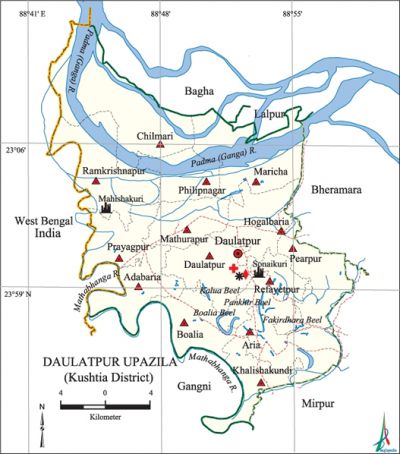Daulatpur Upazila (Kushtia District)
Daulatpur Upazila (kushtia district) area 468.76 sq km, located in between 23°52' and 24°12' north latitudes and in between 88°42' and 88°58' east longitudes. It is bounded by bagha and lalpur upazilas on the north, gangni and mirpur (Kushtia) upazilas on the south, bheramara and Mirpur upazilas on the east, west bengal of India on the west.
Population Total 443655; male 228032, female 215623; Muslim 440571, Hindu 2956, Buddhist 64, Christian 13 and others 51.
Water bodies Main rivers: padma and Mathabhanga; Kalua, Pankhir, Boalia and Fakirdhara beels are notable.
Administration Daulatpur Thana was formed in 1854 and it was turned into an upazila in 1983.'
| Upazila | ||||||||
| Municipality | Union | Mouza | Village | Population | Density (per sq km) | Literacy rate (%) | ||
| Urban | Rural | Urban | Rural | |||||
|
- |
14 |
153 |
246 |
18161 |
425494 |
946 |
45 |
35.2 |
| Upazila Town | ||||||||
|
Area |
Mouza |
Population |
Density |
Literacy rate (%) | ||||
|
15.41 |
2 |
18161 |
1179 |
45.3 | ||||
| Union | ||||
| Name of union and GO code | Area (acre) | Population | Literacy rate (%) | |
| Male | Female | |||
|
Adabaria 06 |
7306 |
15149 |
14409 |
33.34 |
|
Aria 13 |
8124 |
14177 |
12858 |
33.09 |
|
Khalishakundi 47 |
5324 |
15906 |
14860 |
42.45 |
|
Chilmari 27 |
12307 |
11044 |
10666 |
22.89 |
|
Daulatpur 33 |
8158 |
17717 |
16739 |
41.39 |
|
Pearpur 67 |
7626 |
16965 |
15962 |
32.75 |
|
Prayagpur 81 |
6754 |
20334 |
19073 |
37.72 |
|
Philipnagar 74 |
5952 |
17642 |
17635 |
35.81 |
|
Boalia 20 |
6443 |
14245 |
13903 |
32.16 |
|
Mathurapur 61 |
6422 |
19365 |
18431 |
36.87 |
|
Maricha 54 |
9036 |
12916 |
12472 |
26.32 |
|
Ramkrishnapur 88 |
12360 |
13737 |
12685 |
37.46 |
|
Refayetpur 94 |
7993 |
14771 |
13696 |
31.15 |
|
Hogalbaria 40 |
7653 |
24064 |
22234 |
42.66 |
Source Bangladesh Population Census 2001, Bangladesh Bureau of Statistics.

Archaeological heritage and relics Hosenabad Rajbari, Neelkuthi at Mahishakundi, Refayetpur Zamindar Bari.
History of the War of Liberation During the war of liberation a number of encounters were held between the freedom fighters and the Pak army at Bangari playground, Baliadanga playground, Mahishakundi, Shyampur, Sherpur, Chilmari, Farazi Bari and at village Goal. A number of Pak army were killed in an encounter with the freedom fighters at Daulatpur on 13 November 1971.
Marks of the War of Liberation Mass grave 6, Memorial monument 1, Roads 10 (Named after martyred freedom fighters).
Noted Religious institutions Baitul Mamur Jami Mosque at Khas Mathurapur Sheikh Para, Daulatkhali Jami Mosque, Andia Kalibari Mandir, Tomb of Panch Pir.
Literacy rate and educational institutions Average literacy 35.6%; male 38.7%, female 32.3%. Educational institutions: college 14, vocational school and college 1, technical college 1, secondary school 95, primary school 187, community school 3, Ananda school 116, madrasa 12. Noted educational institutions: Philipnagar Maricha College (1994), Daulatpur Girls' College (1998), Shyampur Secondary School (1923), Mathurapur High School (1948), Daulatpur Pilot Secondary School (1963), Daulatkhali Secondary School (1967), Maricha Secondary School (1973), Chilmari Secondary School (1973), Daulatpur Pilot Girls' Scondary School (1979), Prayagpur Government Primary School (1905), Daulatpur Dakhil Madrasa (1994).
Newspapers and periodicals Weekly: Kushtiar Kantha; monthly: Daulatpur Barta; periodicals: Pradip, Chander Hasi Badh Bhengechhe, Hisna, Palashi, Parabar.
Cultural organisations Library 8, Shilpakala Academy 1, theatre group 4, cinema hall 3, club 156, women's organisation 4, literary society 2, playground 85.
Main sources of income Agriculture 60.02%, non-agricultural labourer 6.63%, industry 2.20%, commerce 17.16%, transport and communication 2.66%, service 3.82%, construction 0.71%, religious service 0.12%, rent and remittance 0.30% and others 6.38%.
Ownership of agricultural land Landowner 55.07%, landless 44.93%; agricultural landowner: urban 52.78% and rural 55.17%.
Main crops Paddy, wheat, jute, tobacco, cotton, potato, tomato, maize, betel leaf.
Extinct or nearly extinct crops Indigo, kaun, linseed.
Main fruits Mango, banana, jackfruit, papaya, litchi, guava, palm.
Fisheries, dairies and poultries Fishery 7, poultry 250, hatchery 2.
Communication facilities Roads: pucca 68 km, semi-pucca 119 km, mud road 702 km; waterways 8 nautical miles.
Extinct or nearly extinct traditional transport Palanquin, bullock cart, horse carriage.
Noted manufactories Cigarette factory, bidi factory, match factory.
Cottage industries Goldsmith, weaving, bamboo work, cane work, wood work.
Hats, bazars and fairs Hats and bazars are 67, fairs 3, most noted of which are Allahar Darga Hat, Khalishakundi Hat, Baragaradia Hat, Prayagpur Hat, Mahishakundi Hat, Mansatala Maharam Mela and Mathurapur Dargabari Mela.
Main exports Tobacco and tobacco products, betel leaf, tomato, jute.
Access to electricity All the unions of the upazila are under rural electrification net-work. However 23.86% dwellings have access to electricity.'
Sources of drinking water Tube-well 95.33%, tap 0.60%, pond 0.10% and others 3.97%.
Sanitation '19.48% (rural 19.13% and urban 27.23%) of dwelling households of the upazila use sanitary latrines and 50.74% (rural 50.93% and urban 46.62%) of dwelling households use non-sanitary latrines; 29.78% of households do not have latrine facilities.
Health centres Upazila health complex 1, health and family welfare centre 10, health and family welfare complex 6, community clinic 43, clinic 18.
NGO activities brac, asa, EMPD, BASA, AHDO, JASA. [Md. Salim Reza]
References Bangladesh Population Census 2001, Bangladesh Bureau of Statistics; Cultural survey report of Daulatpur Upazila 2007.
